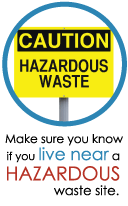Arsenic occurs naturally in water, soil and bedrock and can be at high levels in certain regions of the United States. Arsenic is also released into the environment from human activities such as mining, agriculture, industrial activity or energy production. Find out if you live near a location with higher arsenic due to natural sources or human activities to be sure you know about all possible sources of arsenic in your world.

Where is the Arsenic?
Arsenic occurs naturally in water, soil and bedrock and can be at high levels in certain parts of the United States, particularly the West, the Midwest, parts of Texas and the Northeast.
Even so, arsenic can be a problem no matter where you live. Learn more about the land and water where you live and how you might also be exposed to arsenic through water, food and other sources.

In the U.S., high concentrations of naturally occurring arsenic are more common in the West, Midwest, parts of Texas, and Northeast, but can occur almost anywhere. This map shows the probability of arsenic in private well water greater than 10 parts per billion (ppb), the federal maximum contaminant level for arsenic in public water supplies (New Hampshire and New Jersey have adopted 5 ppb as their regulatory limit for public water systems). Note: 1 ug/L is the same as 1 ppb. Remember, arsenic is not just a problem in those regions, so test your well for arsenic no matter where you live. Data and map from U.S. Geological Survey
Why do parts of the U.S. have higher arsenic?
Arsenic occurs naturally in water, soil and rocks in certain regions of the U.S. Mining, industrial work, energy production and farming can also cause high levels of arsenic in nearby areas.
Arsenic levels in water and soil may be higher near:
- Current or former metal processing operations, power plants or places that make cement;
- Former fruit orchards treated with lead-arsenate pesticides;
- Current or former metal ore mines;
- Old landfills;
- Hazardous waste Superfund sites that have arsenic.
WHAT YOU CAN DO
Drink Safe Water
- If you’re worried about arsenic where you live, contact your state health department or your local health department to learn more about the issue and ask if there could be arsenic in your soil or water.
- Test your water for arsenic if you have a private well.
- If you are on a public water supply (not a private well), ask your water provider for its “consumer confidence report” or “water quality report.”
Test Your Soil
- Find out if your state has high levels of arsenic in the soil.
- If you like to garden or have children who play outside, you may want to test your soil. Use the search term “soil testing” in your internet browser or check your state or Cooperative Extension Service websites.
- Learn how to lower arsenic in homegrown veggies.
- Teach kids to wash hands after playing in soil and before eating. Find out about other ways to keep your kids safe.
Be Proactive
- Visit your state department of environmental quality online to see where existing Department of Defense and state and federal Superfund sites are located. You can visit the U.S. Environmental Protection Agency to learn more about federal Superfund sites and toxic chemical releases and pollution prevention activities.
- Learn if you might be exposed to arsenic in food or other sources.
- Follow the What You Can Do action steps to reduce your total arsenic exposure.

“Know the land! Some places are more likely to have high levels of arsenic in their soil and water because of actions that have taken place there. To help improve your health, learn whether or not there are high levels of arsenic near you.”
Dr. Monica Ramirez-Andreotta, University of Arizona
